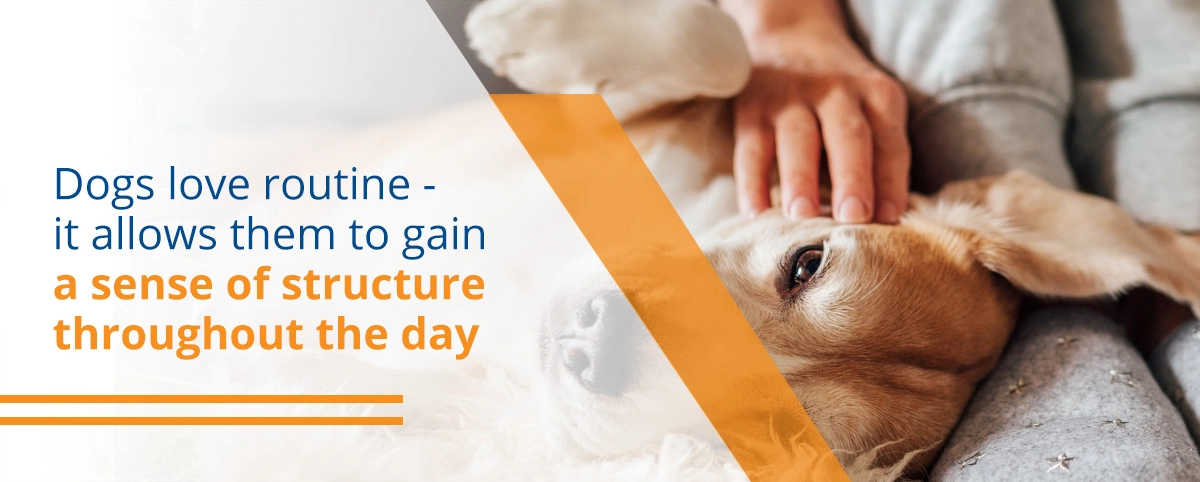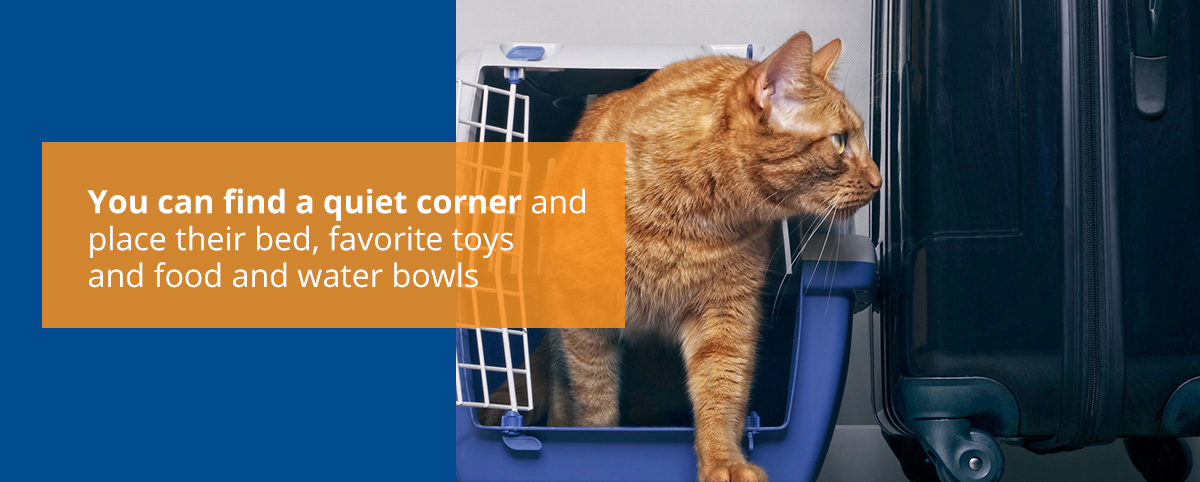
Moving to a new place is a stressful time that can be challenging for you, your children and your furry family members. Pets rely on routines and familiar surroundings to add a sense of stability and order to their day, which can make introducing a cat or other pet to a new home a delicate process.
A move can throw your pets’ routines into flux and result in stress and anxiety. Adding some familiarity and showing patience are simple ways to make a move more manageable for everyone. With some tips to create a calmer pet during the moving process, you can take some pressure off of your shoulders, as well.
There are similarities and differences to how dogs and cats handle the moving process, and we have some tips to help you figure out how to adjust your pet to a new home.
How do you introduce a cat to a new home?
As a cat owner, you might have discovered that felines tend to be resistant to change. Moving cats to a new home can throw a wrench in their daily life, though each of your pets will handle the move a little differently based on their threshold for change.
Moving with cats can be challenging, but adopting some useful strategies can aid you in the process. Here are some tips for moving with a cat.
Carriers will help your cat feel safe and protected during the move. This small shelter will add a sense of constancy amidst all the changes and chaos. You’ll want to make this carrier as familiar and as appealing to your cat as possible well before moving day. By the time that day comes, they’ll be familiar with their carrier and associate it with something good. There are a few different ways to forge a positive connection between your cat and the carrier:
With a carrier, you can make introducing a cat to a new home a little easier.

When you get to the new home, it’s likely to be chaotic for at least a few hours, maybe even a few days. If you’re trying to figure out how to move with a cat while minimizing their stress, find a room that you know will be free from mountains of boxes and shuffling feet. Place some favorite toys, food and treats in the room, and place the carrier on the floor with the door open. Close the door to the room and let your cat acclimate to the new space while you finish unpacking boxes.
Many people wonder what to do with pets when moving. Having one room designated to your pet as a haven from the chaos of the move will help them get some space from added stressors and give them time to acclimate at their own pace. Hiring a professional moving company can help the process go faster and smoother to give your cat — and you — the peace and quiet to acclimate.
Small, everyday items can go a long way in adding some much-needed familiarity to your cat’s new move. Bringing your cat’s familiar litter box, bed or favorite toy will help associate the new home with safe items from the past.
Engaging in some typical play can also help ease the stress of moving with pets to a new home. Bringing along the laser pointer from your previous home will help acclimate your cat while giving you a break to recharge.
It may be tempting to let your cat roam free when you move in, watching them take in their new surroundings and explore their new world. However, this could be an overwhelming experience for some cats and create additional anxiety for your pet.
Instead, consider gradually exposing them to one room at a time, with added familiar items in each to add a sense of comfort. Taking it slowly and adding items from the previous home can help your cat acclimate without getting overstimulated by all the new surroundings.

As your cat gets used to the new place, one of the best things you can give them is some love and attention. The transition of a recent move is a hectic time, and it can be easy to get caught up unpacking and integrating into your new home. Make sure you carve out some time to play, snuggle with your cat and reassure them that the move hasn’t changed your relationship. Though familiar toys and litter boxes can help add some stability, you are the most important source of stability in their lives.
Cats can view their owners as a source of security and stress relief, so merely being around your cat and showing them some attention can go a long way toward welcoming them into the new home.
When you’re introducing your cat to a new home, it’s important to hold on to your patience. While you may be motivated to make the new house feel like home as quickly as possible, your cat might have a different way of getting used to the place. Building a positive relationship with the carrier, adding familiar items and gradually exposing them to their new environment will help ensure they feel comfortable in their new space.
If your cat starts behaving differently when they arrive at their new home, rest assured that this is a normal reaction to all the changes they’re experiencing. The best way you can help is to stay patient throughout the process and let your cat acclimate in their own time.
If your cat is still having trouble getting used to their new space, you can consult your vet for medication that might help calm them during the transition. You can also consider trying out various sprays and scents to create a calming effect on your cat, though you should run any home treatments by your vet first.
Like cats, each dog will handle the transition uniquely. Sometimes dogs can handle a move without a hitch, taking the new environment in stride and happily exploring each room. Others — especially older dogs — might find it more challenging to get used to new surroundings.
In all cases, it’s important to consider various techniques when dogs are moving to a new home and find a combination that will work best for your pet.
You probably stick to a daily routine without even thinking. You wake up, brush your teeth and eat breakfast at about the same time each day. Just as our routines give us a sense of stability, they can be beneficial for your pet, as well.
Dogs love routine — it allows them to gain a sense of structure throughout the day. Dogs feel safest with structure and routine — something that’s in short supply when you’re moving a dog to a new home. Sticking to regular feeding times, bathroom breaks and playtime throughout the day will add some much-needed familiarity to your dog’s day in a new environment. Structured routines help show a dog how to settle into a new house.

Moving with a dog frequently creates some stress as they get used to their new surroundings. One easy way to help them blow off steam is to give them some exercise. Play fetch, walk them around the new neighborhood or play some tug-of-war with a toy. The activity will help them acclimate to the new space while also dealing with the added layer of stress about moving.
As you unpack and make your new place feel like a home, it’s important that you designate an area where your dog can go and feel safe. You can find a quiet corner and place their bed, favorite toys and food and water bowls. Grouping their things this way will let them know that this is their place to sleep and acclimate and give them a sense of calm amidst all the change happening. It’s a great way to introduce your dog to a new house.
Everyone who’s ever had a dog knows they love attention. While you’re caught up in the details of your move, be sure to make time to show some love to your pet. Even a little bit of time with your dog will let them know that you’ll still be there for them in this new place.
Carving some time out of your day to return your dog’s affection makes an excellent break for you, and it might be just what they need to make their new environment feel like a real home.
You may want to consider spending some time at home when you first get to your new place. Being alone for their first few days in a brand new house can be a major cause of stress and anxiety for your pet, and they may be left feeling fearful or neglected.
For the first week, consider working from home, having friends over instead of going out or making sure at least one family member is around most of the time. Having family around will give your dog a central point of familiarity as they get used to the environment.

Staying calm, being patient and going through the previous steps will help your dog transition to the new place.
If they still seem like they’re having trouble acclimating, you can consider consulting a vet about some anti-anxiety medication.
When developing your integration strategies for your dog or cat, you should also consider the age of your animal — moving an older cat to a new home, for example, will present some additional challenges.
How can you make moving easier on pets? For animals of all ages, central strategies to keep in mind while you’re moving to a new house with your pets are:
One particularly challenging scenario is a prolonged move that lasts for days or even weeks. Moving out of state with a dog or cat can be particularly exhausting. In this case, it’s best to get everything unpacked at once so you can spend more time with your pet and make sure they feel at home. Hiring a reliable, trusted moving company can help you get the job done quickly so you can move on to helping your pet acclimate.
Transtar Moving Systems provides fully-trained professional personnel to take comprehensive care of your move. With our award-winning service, we can adapt to any challenges we might face during the move. You can count on us to be on time, load and deliver your belongings and guarantee that you have an exceptional moving experience.
Our courteous, hardworking employees are ready to make your move as easy as possible. Contact us to get a free quote today!